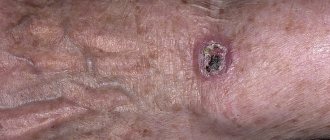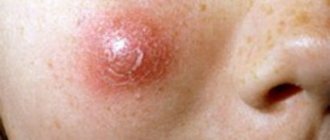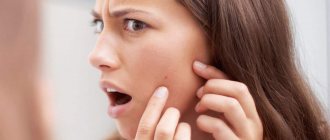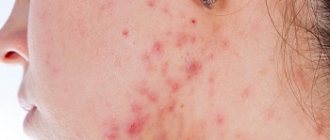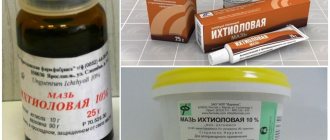What does it look like. At first, the rash appears as red, flat spots that appear on the face. During the day, the number of spots increases significantly and becomes more convex; there is liquid inside each spot. Within four days, the rash can cover the entire body, even appearing in the eyes and mouth. Chickenpox is accompanied by severe itching; it is better not to scratch the spots to avoid infection. At 2-3 weeks, the rash begins to crust over and fall off without any help.
Chickenpox is not such a terrible disease if you have it in childhood. But getting chickenpox as an adult is much more serious. The consequences can be the most unpredictable.
Yes, chickenpox is not a very pleasant disease and being covered in these spots is not very nice. It is better to get over this disease in childhood. As an adult, this all becomes much more unpleasant.
Chicken pox is an infectious disease in which a reddish rash appears on the body, which turns into small blisters. In today’s article we will look at photos of chickenpox in children, what it looks like at the beginning of the disease, what the rash looks like after a few days, whether there can be complications and what they are.
Be sure to compare photographs of a child and an adult, because they say that the disease in children is milder. Let's also see what acne looks like in one-year-old babies.
What is prohibited to use
How to smear a chickenpox rash so that there are no scars left on the body? In this case, doctors categorically prohibit the use of such drugs:
- Is it possible to smear chickenpox with iodine or similar drugs? This cannot be done. After treating the skin, iodine increases all unpleasant sensations, causing the rash to itch more.
- Is it permissible to smear chickenpox with alcohol? It is also strictly prohibited to use it. Alcohol causes burns, which leads to the appearance of scars where the crusts have fallen off.
Some doctors recommend completely avoiding treating rashes caused by chickenpox.
What to apply to the rashes of an adult patient
The most common method is to treat the rash with brilliant green. Zelenka was used for chickenpox by our grandmothers. However, currently there are a large number of different medications that can be applied to chickenpox rashes in adults. Classification of drugs:
- Antiseptic dyes.
- Anti-inflammatory.
- Antiallergic.
- Antiviral.
- Preparations based on zinc compounds.
- Healing.
- External antiseptics.
Antiseptic dyes
Well-known representatives are Fukortsin, brilliant green, methylene blue. They perfectly dry the blisters, have antiseptic properties and will not allow infectious microflora to multiply. They prevent complications such as infection and help form a protective layer of the wound in the form of a crust. All representatives of this group are excellent for smearing chickenpox rashes in adults, but they do not wash off well with water (methylene blue is slightly better than brilliant green). If a person needs to go out into society, these medications can cause discomfort and it is better not to smear chickenpox on the face of adults with any of these substances.
Anti-inflammatory drugs
In modern pharmacology, there are a huge number of anti-inflammatory drugs that are suitable for smearing chickenpox rashes in adults. These drugs are of hormonal (GCS) or non-hormonal (NSAIDs) origin. Anti-inflammatory medications are often colorless. For chickenpox in adults, these medications can also be applied to the rashes on the face. The advantage of these drugs is their calming and analgesic effect. By reducing inflammation, anti-inflammatory ointment relieves redness and swelling in the affected areas. Itching and pain subside. However, it is recommended to use these medications with preliminary antiseptic treatment, for example, Miramistin, to prevent infection in the burst vesicle. Use representatives from this list 3 times a day, applying to the affected areas. The main representatives of the GCS: Sinaflan, Prednisolone, Lokoid - they help eliminate itching and improve healing. Representatives of NSAIDs: Ibuprofen, Diclofenac, Ketonal - eliminate redness and pain, reduce swelling, but slightly relieve itching.
Antiallergic (antihistamine) drugs
This group of medications is what to apply to chickenpox in adults to relieve itching. Antiallergic drugs are not the first choice drugs in the treatment of external manifestations, but they can have an auxiliary effect together with other drugs. By affecting the causes of inflammation and itching, antihistamines partially relieve the external manifestations of the disease. They reduce redness, reduce the burning sensation, but do not fight bacterial and viral infections and do not directly affect the rate of tissue healing. Main representatives: Psilo-balm, Fenistil gel.
Antiviral ointments
Antiviral substances for external use do not have 100% confirmation of their effectiveness. Scientists disagree on whether it is worth treating chickenpox with antiviral drugs in adults. However, it has been proven that the use of these suspensions without excipients does not lead to a positive result, since the virus that causes chickenpox is inside the body and the substance is simply not capable of killing it. But, on the other hand, there is an opinion among doctors that this group of drugs significantly speeds up the healing process. It is up to you and your treating specialist to decide. Representative - Viferon Gel.
Preparations based on zinc compounds
The basis of such drugs is zinc oxide. Even before the discovery of viruses, a mixture of zinc oxide was applied to chickenpox blisters. This substance has antiseptic, drying, and anti-inflammatory properties. Does not leave a strong cosmetic mark and is easily washed off with water, has a white color. Practically does not cause allergic reactions. Therefore, it is the main favorite when choosing what is best to smear the chickenpox rash in adults. An almost ideal choice for those with chickenpox, the only drawback is that it does not eliminate itching. This group of medications must be combined with the internal use of antihistamines. The main representatives are Zinc ointment and Tsindol.
Healing drugs
It is better to smear chickenpox in adults already at the crust stage. They perfectly help the epithelium to recover in order to avoid possible consequences in the form of scars. It is not the first choice drug for chickenpox. However, the use of ointments from this list becomes almost a necessity, since the skin of older people recovers worse than that of children. The main choice: Solcoseryl, Actovegin, Eplan.
External antiseptics
The most extensive list of medications consists of representatives of this group. These drugs include all drugs that have antiseptic properties. One of the important representatives of this list is Miramistin. It can be used perfectly for rinsing the mouth in case of rash. Also suitable for rinsing the mouth is a strong decoction of herbs that have antiseptic properties, such as chamomile, calendula, tea tree. For chickenpox in adults, the rash can be treated with Chlorhexidine. This strong antiseptic is often used after the bubble has burst. To prevent infection, it is necessary to apply to the affected areas of the skin up to five times a day.
What not to apply to rashes
The most common myth is the need to use tanning agents. Tanning properties negatively affect the subjective feeling of dried bubbles. A feeling of a foreign body appears on the skin, and itching may intensify. Also, after tanning agents, the likelihood of scar formation increases, after the crust separates. Oak bark, alcohol and other tanning agents can leave a visible defect on the skin, so using them on the face is contraindicated, even in case of good skin. It is often mistakenly believed that 95% medical alcohol is a good preventative against infection of burst blisters. This is a common mistake. You should not apply alcohol to chickenpox rashes in adults. There are many other antiseptics that do not have tanning properties.
Why you should look for an alternative to brilliant green
What to apply to pimples for chickenpox instead of brilliant green? In addition to this remedy, there are many other alternative drugs. Chickenpox in children, in addition to brilliant green, can be treated with antiseptics or antiviral compounds. They will speed up healing, prevent infection and help the skin recover faster.
Usually, doctors recommend using chickenpox instead of brilliant green:
- Tsindol. An effective and safe product that helps reduce inflammation, dry the skin, and speed up the healing of existing wounds. The drug destroys pathogenic microflora.
- Calamine. What is the correct way to apply chickenpox other than brilliant green? Calamine lotion is the best choice because it is made exclusively from natural ingredients. In order not to provoke secondary infection of skin lesions, it is recommended to treat the rash with this drug up to seven times a day. As a result of its use, the child’s body stops itching, which has a beneficial effect on well-being.
- Fukortsin. This antiseptic has a drying effect. Fukortsin has a bright crimson color, but is easily washed off from skin and clothing.
- Acyclovir. If the question arises about how to treat chickenpox, you need to try this drug. It is used in severe cases of the disease to eliminate the activity of the virus. This ointment for chickenpox is used if there are strict indications.
- PoxClean. This spray is good for treating itchy rashes. It dries the skin and speeds up healing. All these positive qualities are provided thanks to the content of aloe vera.
Now doctors say that using brilliant green does not make much sense (if you do not take into account the convenience of controlling new rashes), because it has no effect on the Varicella-Zoster virus, which is the causative agent of chickenpox. The medication has only an antiseptic effect.
According to research, the active use of brilliant green causes the virus to spread to nearby tissues.
Another significant disadvantage is soiled clothes and bed linen, which will take a long time to reanimate, and, of course, the baby’s body (it will be covered in stains for many more days).
The psychological aspect is also important - the abundance of green dots can negatively affect the still fragile and receptive child’s psyche. This may make him feel uncomfortable, afraid that they will laugh at him and no one will want to be friends with him.
As you can see, brilliant green is not a panacea and there is more than one cure for chickenpox for children instead of brilliant green. In addition, they are no worse, and sometimes better, more effectively cope with the function of disinfecting the skin and relieving itching.
What is chickenpox?
Chickenpox is an infection caused by the Varicella zoster virus. Spreads through direct physical contact, sneezing or coughing.
The picture shows what the Varicella Zoster virus looks like:
This is how the virus spreads through the bloodstream throughout the human body:
Children are most susceptible to the disease, but adults can also easily become infected if they have not been sick before. Moreover, the course of the disease in adults will be much more acute: high fever, very profuse rashes, ulcers on the body.
Prevention methods
The only way to protect yourself from infection is through vaccination. A weakened virus is introduced into the body, which the immune system can cope with without problems. To prevent infection of others, the patient should be isolated. An infected child is also not allowed to attend kindergarten or school. The room where the patient is located must be ventilated several times a day and wet cleaning done.
Remedies for chickenpox can only be prescribed by your doctor. Pregnant women and infants must be given immunoglobulin on the first day after contact with a sick person. This will help prevent the development of the disease or tolerate chickenpox in a mild form.
The onset of chickenpox
The first symptoms of chickenpox can be detected after about two to three weeks from the moment of infection; the exact time depends on the immunity and age of the patient.
The period of occurrence of unpleasant symptoms during chickenpox is called prodromal in medicine. Days pass and may not appear in everyone.
Symptoms:
- Weakness
- Headache
- Temperature
- Loss of appetite
- Chills
- Enlarged lymph nodes
- Muscle withdrawal.
Both adults and children suffer from chickenpox, but the most common age of infection is under 5 years.
Doctor Komarovsky's opinion
A popular pediatrician confirms that brilliant green is very popular for treating chickenpox rashes, but at the same time assures that there is no particular need to use such a dye for this infection.
For more information about this, see Dr. Komarovsky’s program.
Applying green dots to new pimples every morning can, of course, help mom notice the moment when new pimples no longer appear. And after 5 days the baby will no longer be infectious to others. However, Komarovsky emphasizes that even without brilliant green, from the 7th-8th day of illness, when all the pimples have crusted over, the child is no longer contagious to other people.
The famous doctor believes that the use of brilliant green should be a personal decision for each mother, but there is no great need to lubricate the chickenpox blisters with brilliant green, since chickenpox heals remarkably well without such treatment.
Iodine for chickenpox
Iodine is not recommended for use as an antiseptic for chickenpox. Lubricating pimples with this drug does not give the desired results. In addition, iodine aggravates the infection . The product has an aggressive effect on the lesions. The damaged wounds burn severely and intensify the itching.
Doctors do not recommend using iodine solution to eliminate acne not only in children, but also in adults.
Chickenpox is an infection that can cause dangerous complications. You should not self-medicate if signs of chickenpox appear. It is necessary to visit a doctor who will select an effective drug to alleviate the condition and relieve discomfort.
Decoctions for bathing
Various herbal infusions for bathing are especially popular. The procedure helps eliminate discomfort caused by rashes and speed up the healing process of wounds. Do not use cosmetic cleansers. After bathing, never rub your skin with a towel.
Chamomile has antiseptic and anti-inflammatory properties. Flowers and grass (50 g) must be brewed with 1 liter of boiling water and left to infuse. The strained infusion is added to the bath. The duration of the procedure is 10-15 minutes. Calendula is used in a similar way. Such folk remedies for chickenpox for children can also be used.
You can lubricate the affected skin to relieve itching with tea tree oil. It has an antiseptic effect, soothes irritation and inflammation. It is better to use a cotton swab to apply to the rash.
How to treat chickenpox in adults
Vaccine (inoculation)
Other than vaccination, there are no countermeasures to combat the spread of chickenpox. The synchronous introduction of chickenpox vaccination and other vaccines into the body in different places and with different syringes is safe and effective, preventing the possibility of treatment in the future. However, in order to provoke a similar immune response (as with the use of a monovalent vaccine).
Pictured is vaccination against chickenpox
The dosage of the component must be increased so that transmission of the virus in the future is impossible, as well as the use of brilliant green, other means and more serious treatment. All this will eliminate the possibility of getting sick and becoming infected in the future, because in this case the illness will last even longer.
Poksklin instead of green stuff
Medical cooling hydrogel for significant relief of chickenpox symptoms. Accelerates the immediate process of rapid healing and effectively prevents the formation of scars on the skin. It is often used for chickenpox in children, just so as not to smear the child with brilliant green. And this is not surprising, since this product has a number of advantages:
- does not leave stains;
- Allowed for children from 2 years of age;
- does not contain chemicals or toxic substances;
- prevents the development of infectious diseases by harmful pathogenic bacteria and pathogenic microbes;
- does not exhibit particularly harmful effects on the human body’s own cells;
- does not create addiction;
- does not have a negative therapeutic effect;
- has a long-lasting cooling effect for rapid, significant relief of chickenpox symptoms;
- consists entirely of natural components (panthenol, aloe vera, chamomile and lavender extracts);
- provides a cooling, soothing and softening therapeutic effect;
- convenient and harmless to use.
This preparation is convenient for systematic application - while the local distribution of thick protective creams and medicinal ointments throughout the body can easily lead to serious damage to the bubbles, the cooling hydrogel is very easy to apply locally and does not cause friction in tactile areas when spread on the skin.
What ointments can be used for chickenpox to prevent pimples from forming into scars?
It is not uncommon that after chickenpox, scars remain in place of the pimples.
Adults especially often suffer from this consequence of the disease, since the skin is no longer so well renewed. To prevent scarring, it is recommended to use the following medications:
- Mederma;
- Contractubek;
- Bepanten;
- Dermatis;
- Medgel;
- D-Panthenol;
- Gistan-N.
Each drug has one contraindication – hypersensitivity to the active substance. Before starting use, it is recommended to test on a small area of skin.
What else can you do to treat rashes?
If a mother is interested in what can be used instead of brilliant green and zinc products, then she can be recommended:
- PoxClean. This hydrogel contains aloe vera, so it has a beneficial effect on skin inflamed due to chickenpox, soothing it, reducing itching and relieving swelling.
- Salicylic alcohol. The drug dries out the blisters quite effectively, accelerating the regeneration processes in the skin, but you should use alcohol carefully to avoid drying out the skin.
- Tea tree oil. This product prevents infection of damaged skin and relieves inflammation. At the same time, it is natural and does not have a drying effect.
- Fenistil. This medicine from the antihistamine group, produced in the form of a gel, is often used for chickenpox. Lubricating the rash with Fenistil helps to quickly relieve itching and swelling, cools the skin and soothes it.
- Potassium permanganate. To treat the rash, use a transparent solution of this product, pale pink in color (5%). You should use potassium permanganate to lubricate the skin of a child with extreme caution, because a high concentration of the drug can cause burns.
- Hydrogen peroxide. This colorless liquid has a pronounced antiseptic effect and prevents infection of the blisters.
- Baking soda. Having prepared a 5% solution from it, the product is applied to the skin to eliminate itching and dry out the blisters.
How to cauterize chickenpox
Most often, vesicular rashes with chickenpox are cauterized. For this, many people use medical alcohol. The advantage of this method is that this product does not leave marks on the skin and clothes.
An equally popular way to dry and disinfect wounds is a weak solution of potassium permanganate. However, alcohol and potassium permanganate should be used with caution. These substances can leave burns on the affected areas, thereby worsening the patient's condition.
The most popular external remedies for the treatment of chickenpox remain Fukortsin and brilliant green. They have antiseptic properties, prevent the development of infection in areas of inflammation, dry wounds and promote their speedy healing.
The main disadvantage of these drugs is stains on the body and clothes, which are difficult to wash and remove. Therefore, most people are looking for alternative ways to treat chickenpox blisters.
What to smear in the mouth and on other mucous membranes, on the genitals
If the chickenpox rash appears not only on the surface of the skin, but also in intimate places, in the eyes or in the mouth, this causes additional discomfort to the child.
To process it you can use:
- Furacilin.
- Miramistin.
- Boric acid (1% solution).
- A weak solution of potassium permanganate.
- Oil solution of chlorophyllipt.
- Infusion of calendula, sage or chamomile.
- Sea buckthorn oil.
- Kalgel.
- Kamistad.
Apply medications to the genitals, mucous membranes of the mouth or eyes should be very careful.
The use of antibacterial agents for chickenpox rash on the genitals and other mucous membranes is contraindicated.
Differential diagnosis
photo of pimples due to chickenpox
A rash similar to chickenpox also occurs with other diseases. The most common are:
- Coxsackie virus;
- herpetic sore throat, stomatitis, herpes simplex on the skin;
- streptoderma;
- bites;
- strophulus.
Acne that looks like chickenpox, but is not chickenpox, is most often characteristic of an enterovirus. This damage to the skin and mucous membranes is initiated by a type of pathogen - the Coxsackie virus:
- The palms and soles of the feet are always affected;
- there are profuse rashes in the mouth;
- the temperature is very high, rises mainly in the evening and at night, lasts 5-7 days;
- at the stage of completion of the pathology, characteristic changes in the nails appear;
- spots appear on the entire surface of the affected skin, then blisters dry out and the skin peels off.
Among the rashes similar to chickenpox, there is a bacterial streptococcal inflammation of the skin, the first symptoms of which can be confused with the onset of chickenpox. The following differences are inherent:
- low temperature;
- absence of prodrome;
- More often than not the whole body is affected, but a certain area of the skin;
- the mucous membrane is not involved;
- the blisters that form are not dense, they are filled with purulent contents, which dry out into a yellow crust;
- Erosion may form.
Many parents are concerned about pimples due to pruritus, since in young children strophulus is often registered more often than chickenpox. The differences are as follows:
- the pathology involves the lower half of the body (lower back, buttocks, lower limbs);
- the rash itches very much;
- no fever;
- there is often a connection with allergies;
- papules and blisters form;
- the oral cavity is not involved.
Herpes simplex on the skin is localized in groups of blisters, most often on the lips, wings of the nose, and genitals. The rash is preceded by pain, swelling, and itching. There is no coincidence of fever and the appearance of a rash. With herpetic stomatitis, there are many ulcers, the pain is severe, but there are no rashes on the body.
What to apply to a chickenpox rash?
A rash all over the body is one of the main symptoms of chickenpox. It appears on the first or second day of illness and quickly spreads throughout the body, and in some children it also appears on the mucous membranes. At first, the rash appears as spots that quickly transform into papules, and then into blisters. Such blisters with chickenpox itch quite badly, so every mother is interested in what is the best means to smear sores with chickenpox.
In addition, if the skin is not treated, many children scratch the rash and tear off the scabs, resulting in the formation of wounds that will remain on the body in the form of scars for the rest of their lives. And therefore, the correct choice of anti-itch remedy is important both for eliminating discomfort and for the child’s appearance.
The first manifestations of chickenpox
The first symptoms of chickenpox appear 1-3 days before the first elements of the rash characteristic of the infection appear. The onset of chickenpox (namely the infection itself) is accompanied by the following symptomatic manifestations:
- Temperature rises to 38 degrees or slightly above 37 degrees;
- Chills;
- Weakness and lethargy;
- Headache;
- There may be increased sensitivity to bright light;
What does chickenpox look like in adults before the rash appears? The above symptoms develop into a more aggressive form within 24 hours and are supplemented by:
- The temperature reaches 38-39 degrees, and in some cases can reach 40 degrees;
- Fever;
- Malaise;
- Acute headache;
- Nausea, vomiting;
- Muscle spasms and convulsions, involuntary twitching of the limbs may be observed;
- Pain in joints and muscles;
- In some cases, delirium and loss of coordination of movements may occur;
- High sensitivity to bright light;
Symptoms of chickenpox include cough, runny nose and swollen lymph nodes. These manifestations are not typical for this infection, and the onset of cough and runny nose can be observed only after the appearance of a rash on the mucous membranes of the throat and nose.
Note that all these symptoms may appear before the rash, or they may appear after the rash.
Dr. Komarovsky’s advice on how to behave if there is a child with chickenpox in the house:
- You should not wrap your child up, as this will cause overheating. This makes the itching even worse.
- The room should be ventilated as often as possible.
- Your child's nails should be trimmed short. If necessary, use gloves. A sick child must be constantly distracted so that he does not scratch the blisters and introduce an infection there.
- To avoid causing liver complications, forget about lowering your temperature with aspirin.
- If the baby scratches the blisters and bacteria gets into the wound, the marks will remain forever.
- Remember that chicken pox significantly affects the child’s immune system, and after recovery occurs, it is better for parents to take care of the baby and give him the opportunity to recover at home. You need to walk in the fresh air as much as possible. Only after you notice that the child has gained strength can you return to kindergarten.
When it comes to vaccinations, parents make their own decisions to take responsibility into their own hands. Vaccination against chickenpox is carried out on a voluntary basis and parents need to carefully study this issue in order to make the right decision.
Chickenpox begins with a sudden increase in temperature and the appearance of watery blisters on the body that spread over the entire surface of the skin. As a rule, the first rashes are localized on the torso or scalp. In rare cases, patients notice rashes only on the arms and legs. This manifestation of the virus is not typical, but it does occur, so it is important to distinguish it from other diseases. Next, we will consider how chickenpox manifests itself on the palms and soles, what diseases it can be confused with, as well as treatment methods.
How does chickenpox spread in children?
Many parents mistakenly think that chickenpox infection occurs from contact with itchy blisters, and that they are the source of infection. But the danger from viruses lies in droplets of mucus from the nasopharynx of a sick baby. For this reason, two days before blisters begin to appear on the child’s body, his infected body becomes a source of infection for the people around him. You can become infected through playing together, in close contact, talking, or simply by being in the same room. The virus from the nasopharynx of a sick baby enters the air, which is inhaled by children and adults. The virus settles on the mucous membrane of the pharynx, oral cavity, nasal cavity, and with the flow of lymph and blood rapidly spreads throughout the body, actively multiplying.
The incubation period lasts from 7 to 21 days, and during this period the virus does not make itself felt in any way, and nothing bothers the baby. The virus is highly volatile, and it easily travels a distance of twenty meters, successfully penetrating the respiratory tract of a healthy person. Therefore, you can become infected even through ventilation. In rare cases, infection can also occur from an adult who suffers from herpes zoster. This disease, like chickenpox, has one pathogen - the culprit is the herpes virus Varicella-Zoster.
Who is most at risk for chickenpox and its complications?
- Newborns and infants whose mothers have never had chickenpox or received chickenpox vaccine.
- Pregnant women who have not had chickenpox or have not been vaccinated.
- People who are immunocompromised, such as those who take medications that suppress their immune system or those who have diseases such as HIV.
- Aged people.
For these categories, if they did not have chickenpox in childhood, vaccination is recommended. The chickenpox vaccine is usually only given to those who regularly interact with people who may have the infection. The vaccine is suitable for men and women aged 1 to 65 years.
What does chickenpox look like in a child? Photo
Every parent needs to know what chickenpox looks like on the body in children, so as not to miss the first main symptoms and not make a mistake with the diagnosis.
Here's what you need to know:
- On the first day of the disease, the baby's skin becomes covered with red pimples, reminiscent of insect bites.
- Next, the pimples transform into vesicles containing liquid inside. Pimples have a red border. When the liquid in the bubble becomes cloudy, it bursts.
- When the burst bubble dries, it becomes crusty on top. Even though they are very itchy, you should not allow your child to pick them off.
- All stages of the manifestation of rashes can be observed simultaneously, and on the child’s body you can notice both red spots resembling insect bites and fluid-filled blisters.
Is it really chickenpox?
Some diseases have symptoms similar to chickenpox, but begin to appear exclusively on the palms and soles. Here are the most common ones:
- Rubella is a viral disease transmitted by airborne droplets. It begins with the appearance of small red spots on the palms, bends of the hands and legs, and then spreads over the body and face. Associated symptoms are fever, runny nose, cough, sore throat, as well as enlarged cervical and submandibular lymph nodes. It is lymphadenitis, together with a rash, that is the main difference between rubella and chickenpox, because in the presence of the latter, the lymph nodes do not become inflamed.
Chicken pox. Click to enlarge
Peculiarities
Chickenpox rash can appear on the torso, and then spread to the limbs or immediately localize to the arms and legs. Simultaneously with the rash, the temperature rises, from low-grade to high (38-39 degrees). The development of the rash occurs as follows:
- First, small pink spots appear on the palms and soles;
- within 24 hours they swell and become papules-like;
- then the spots fill with liquid and turn into bubbles. At this stage, severe itching appears;
- Simultaneously with the development of old ones, new rashes appear, which progress according to the same pattern. Usually this process takes from 1 to 2 weeks; the specific timing of the spread of the rash depends on the patient’s immunity, his age and chronic diseases;
- sometimes chickenpox occurs only on the legs and arms, which makes diagnosis difficult;
- 1-2 days after filling with liquid, the bubbles burst. In their place, a crust forms, which disappears approximately on the 7th day. Under no circumstances should you comb, let alone rip off, as this can cause infection or cause scars to appear on the skin.
Frequently asked questions about chickenpox
How many days do you need to be at home?
The minimum period for the development of the disease from the development of infection to the elimination of the last symptoms is 19 days. 10 days of which is the incubation period. It is important to consider that the maximum possible duration of chickenpox during which you should stay at home is 39 days. It is after this that contagiousness is completely eliminated, there is no need for treatment and there is no danger of becoming infected. You can read more about this here – signs of HPV in men.
How many times do they get sick?
You only get chickenpox once, but the virus is likely to be reactivated, causing it to become pathogenic. In this case, it manifests itself as a recurrent pathological condition, which can become painful and painful unexpectedly, no matter how long it lasts. Development factors may include all kinds of stress, serious nervous strain, or the addition of chronic recurrent pathologies. All of them weaken the immune system, like measles or conjunctivitis and other diseases of the internal organs, the treatment of which requires close attention due to their high contagiousness.
How long does the temperature last with chickenpox?
The temperature with chickenpox in an adult is formed in the second stage, as is the rash. In the first 24 hours, the readings may well jump to very high values, namely 39 or 40 degrees. An increase in temperature will precede the rash; for example, it may form a day or two before the formation of the initial dangerous blisters.
What to smear with besides brilliant green?
Advice: In order to make it easier to tolerate the disease, it is recommended to use other means in treatment other than brilliant green.
We are talking about a solution of potassium permanganate. Many doctors prescribe fucorcin, which is also brilliant green, but of a crimson hue, to treat rashes. It is possible to use zindol if a person has just started to get sick and has not yet become seriously ill. In some cases, the use of tea tree oil is acceptable, but you should consult a specialist before doing so. In this case, the illness will last much less.
Are rubella and chickenpox the same thing?
Chickenpox and rubella are acute, infectious and inflammatory diseases of viral origin. They are provoked by different viral lesions and can be associated with the formation of similar similar symptoms, so they can be confused. Each of the diseases presented provokes an increase in temperature, total weakness, when the contagiousness is still high. However, rubella is generally defined as a much more serious condition in adults, which can last much longer and lead to more severe consequences. They can be much more complicated.
How many days is sick leave given?
In the vast majority of cases, sick leave is issued for 10-14 days. Depending on the degree of aggravation of the disease, the characteristics of the incubation period and symptoms, treatment may be longer. In this case, the sick leave must be extended, observing all the conditions of proper nutrition, so that the infectious person recovers as quickly as possible.
How to wash brilliant green after an illness?
In order to wash or rinse off the brilliant green used to burn pimples, it is permissible to use hydrogen peroxide. It is acceptable to use alcohol-containing solutions, which can deal with traces of brilliant green much faster and more effectively. However, peroxide is much more gentle on the skin and will not damage it.
Another gentle technique is the most common facial tonic. With its help, you will need to wipe the skin several times during the day. In the first minutes, the spots will begin to fade, lose their intense color, and then disappear completely. Another remedy, the most accessible, is lemon. However, its use is permissible only in the absence of an allergy to citrus fruits (you can check the reaction in the palm of your hand).
Is it possible to wash yourself if you have chickenpox?
Bathing with chickenpox is completely permitted and even necessary, because it allows you to wash away sweat and dirt, which provoke subsequent suppuration of contagious infectious lesions.
In addition, water procedures allow you to relax and help relieve itching symptoms (as you know, chickenpox can itch very much). The only condition for washing when necessary is to avoid bathing in hot water and not to use a washcloth.
How is it transmitted through third parties?
Chickenpox can be spread through respiratory droplets such as coughing, sneezing or talking. Kissing can also give you chickenpox. It is even possible that the virus can be transmitted through close bodily contact with third parties. A person who has recovered from the disease develops a stable immunity to the present disease, which will not allow the infectious lesion to appear in an aggravated form in the future.
Symptoms of chickenpox in children and stages of the disease
Chickenpox in children occurs in several stages, which have their own distinctive features:
1. During the incubation period, which lasts from 7 to 21 days, the virus actively multiplies, and the disease does not manifest itself in any way. 2. Prodromal period. If the child is small, then it may be absent or its course will be accompanied by insignificant manifestations. This stage may last 24 hours or a little more, and in external manifestations the disease may resemble a standard cold with the following symptoms and first signs:
- Temperature increase
- Weakness and chills;
- Loss of appetite;
- It is possible that reddish spots may appear briefly on certain areas of the body;
- Sore throat.
3. When blistering rashes begin to appear on the child’s body, a sharp rise in temperature is possible, but this is not at all necessary. According to medical observations, the higher the thermometer rises, the more itchy blisters there will be on the body, and the disease itself will be more severe. If the disease is mild, the increase in temperature will be insignificant, or it will not occur at all. And only a rash that appears all over the body will indicate chickenpox.
